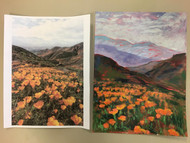Boiling Down Painting Instruction
Posted by Kate Manville-Schwartz on Apr 9th 2021
Our Painting Instruction Method is Tried and True!
One of the best ways to begin your painting journey is to just start. One school of thought is to get good at drawing first, and no doubt, there is value in that, but if you pick the right photo as your inspiration, and you don't get the drawing exactly right, then it's just abstracted. Abstraction means to simplify or distort.
If a teacher is clear on their expectation in a painting class, students can just begin. Often times, one of the first things I do is present a number of paintings of the same thing, ie. a bowl of fruit, and show how there is a multitude of styles, compositions, and color palettes for painting. See below for an example.



Although these paintings are radically different in their approach, there is still a similar process that was implored for each of these examples. Artists had to choose a color palette, paint a ground color, block out their drawing, find shadows and highlights, and apply brush strokes or texture. Boiling down a painting to a series of choices, and then explaining what those choices are, is exactly how a good art teacher helps students find their style, voice and confidence.
Currently, Kate's Art School is enrolling a class called, "Interpreting Your Photographic Reference." Like all classes at Kate's Art School, this class is perfect for students at any stage in their artistic journey. This class runs Thursdays 7:30-9pm, May 13th - June 17th.
This weekly acrylic painting class will offer students the opportunity to work from their own photographic references, or ones will be provided. For this class, students will be creating on tiny canvases. Typically, in painting, it takes several square inches of practice to even recognize if the style, technique and idea is working. Working on small canvases, will give students the opportunity to try, try again, and will help them recognize which small changes make big differences. The topics of drawing, value, color, design, technique, paint mixing, tools, materials and paint application will be addressed. No prior art experience is necessary.

